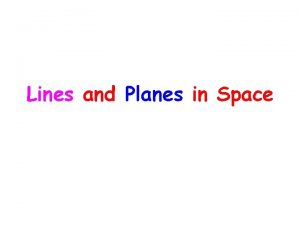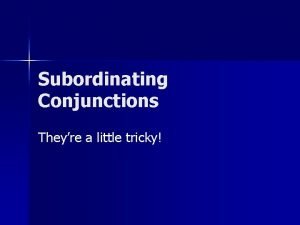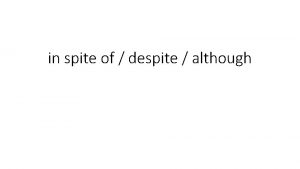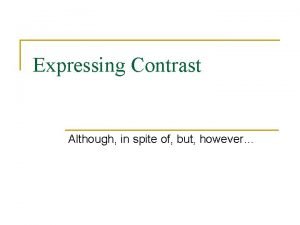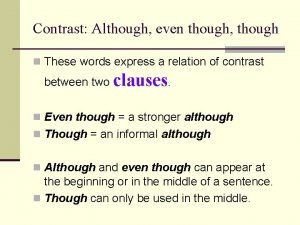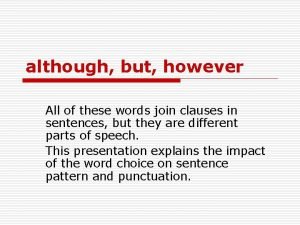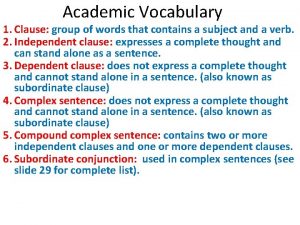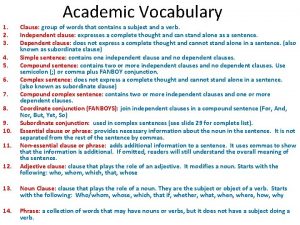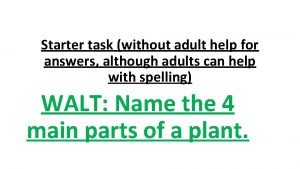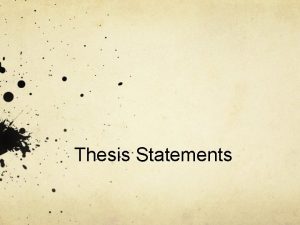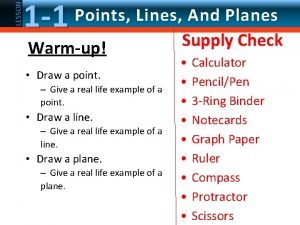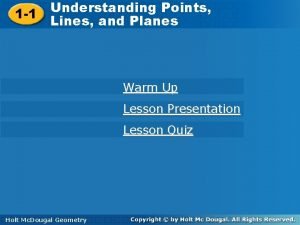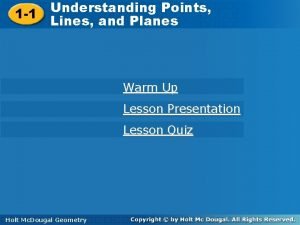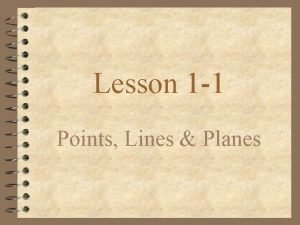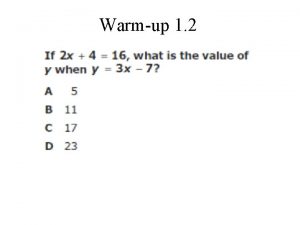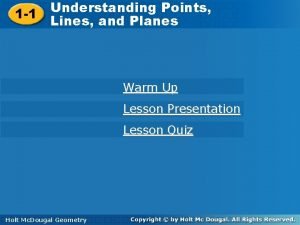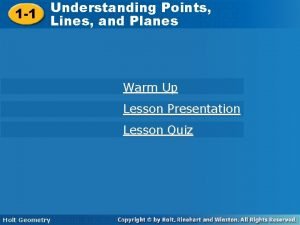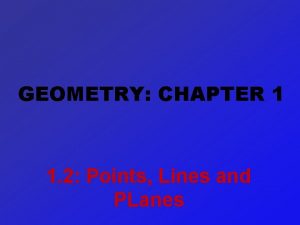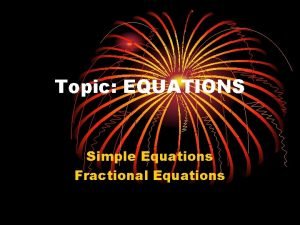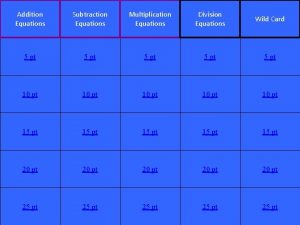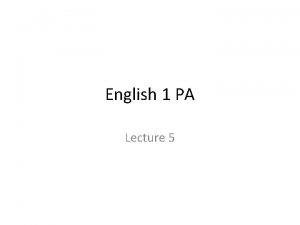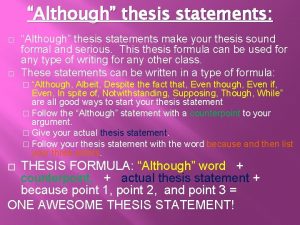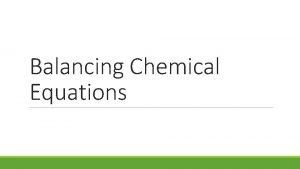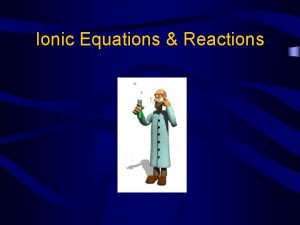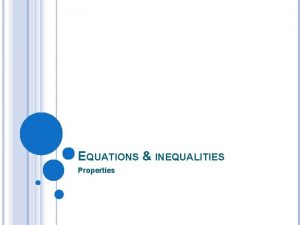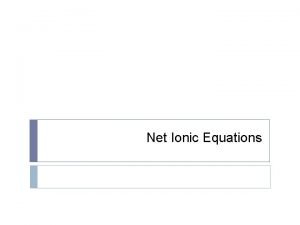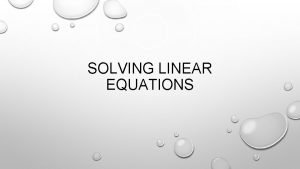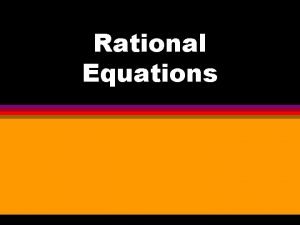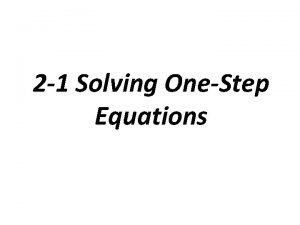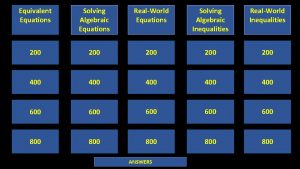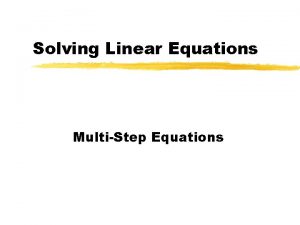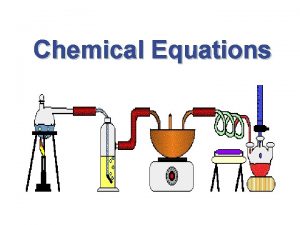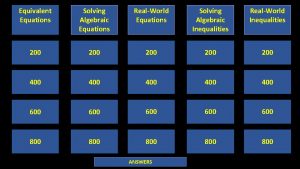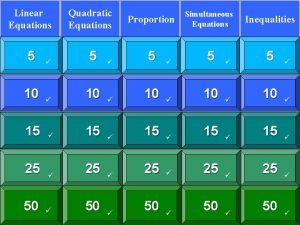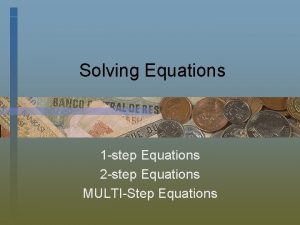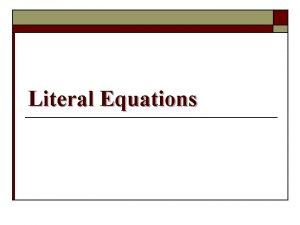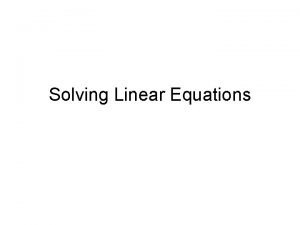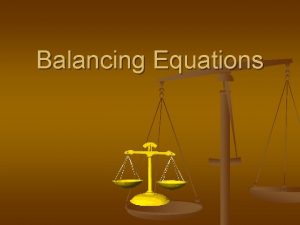Lesson 88 Equations of Planes PLANES Although a




































- Slides: 36

Lesson 88 Equations of Planes

PLANES Although a line in space is determined by a point and a direction, a plane in space is more difficult to describe. § A single vector parallel to a plane is not enough to convey the ‘direction’ of the plane.

Image #1

Image #2

Vector and Parametric Equations of Planes The vector equation of a plane has the form: Where

Example 1 • Determine the vector and parametric equations of the plane that contains the points A(1, 0, -3), B(2, -3, 1) and C(3, 5, -3)

Example 2 • Does the point (4, 5, -3) lie in the plane

Example 3 • Find the vector equation of the plane that contains the two parallel lines

PLANES However, a vector perpendicular to the plane does completely specify its direction.

PLANES Thus, a plane in space is determined by: (1) A point P 0(x 0, y 0, z 0) in the plane (2) A vector n that is orthogonal to the plane

NORMAL VECTOR This orthogonal vector n is called a normal vector.

PLANES Let P(x, y, z) be an arbitrary point in the plane. Let r 0 and r 1 be the position vectors of P 0 and P. § Then, the vector r – r 0 is represented by

PLANES The normal vector n is orthogonal to every vector in the given plane. In particular, n is orthogonal to r – r 0. Thus, we have: n. (r – r 0) = 0 That can also be written as: n. r = n. r 0

EQUATIONS OF PLANES To obtain a scalar equation for the plane, we write: n = <a, b, c> r = <x, y, z> r 0 = <x 0, y 0, z 0> Then, the equation becomes: <a, b, c>. <x – x 0, y – y 0, z – z 0> = 0 That can also be written as: a(x – x 0) + b(y – y 0) + c(z – z 0) = 0

SCALAR EQUATION That can also be written as: a(x – x 0) + b(y – y 0) + c(z – z 0) = 0 § This equation is the scalar equation of the plane through P 0(x 0, y 0, z 0) with normal vector n = <a, b, c>.

EQUATIONS OF PLANES Example 1 Find an equation of the plane through the point (2, 4, – 1) with normal vector n = <2, 3, 4>. Find the intercepts and sketch the plane.

EQUATIONS OF PLANES Example 1 In Equation 7, putting a = 2, b = 3, c = 4, x 0 = 2, y 0 = 4, z 0 = – 1, we see that an equation of the plane is: 2(x – 2) + 3(y – 4) + 4(z + 1) = 0 or 2 x + 3 y + 4 z = 12

EQUATIONS OF PLANES Example 1 To find the x-intercept, we set y = z = 0 in the equation, and obtain x = 6. Similarly, the y-intercept is 4 and the z-intercept is 3.

EQUATIONS OF PLANES Example 1 This enables us to sketch the portion of the plane that lies in the first octant.

EQUATIONS OF PLANES By collecting terms in our equation as we did in our previous example, we can rewrite the equation of a plane as follows: ax + by + cz + d = 0 where d = –(ax 0 + by 0 + cz 0) § This is called a linear equation in x, y, and z.

LINEAR EQUATION ax + by + cz + d = 0 where d = –(ax 0 + by 0 + cz 0) § This is called a linear equation in x, y, and z.

EQUATIONS OF PLANES Example 2 Find an equation of the plane that passes through the points P(1, 3, 2), Q(3, – 1, 6), R(5, 2, 0)

EQUATIONS OF PLANES Example 2 The vectors a and b corresponding to and are: a = <2, – 4, 4> b = <4, – 1, – 2>

EQUATIONS OF PLANES Example 2 Since both a and b lie in the plane, their cross product a x b is orthogonal to the plane and can be taken as the normal vector.

EQUATIONS OF PLANES Thus, Example 2

EQUATIONS OF PLANES Example 2 With the point P(1, 2, 3) and the normal vector n, an equation of the plane is: 12(x – 1) + 20(y – 3) + 14(z – 2) = 0 or 6 x + 10 y + 7 z = 50

Example 3 EQUATIONS OF PLANES Find the point at which the line with parametric equations x = 2 + 3 t y = – 4 t z=5+t intersects the plane 4 x + 5 y – 2 z = 18

EQUATIONS OF PLANES Example 3 We substitute the expressions for x, y, and z from the parametric equations into the equation of the plane: 4(2 + 3 t) + 5(– 4 t) – 2(5 + t) = 18

EQUATIONS OF PLANES Example 3 That simplifies to – 10 t = 20. Hence, t = – 2. § Therefore, the point of intersection occurs when the parameter value is t = – 2.

EQUATIONS OF PLANES Example 3 Then, x = 2 + 3(– 2) = – 4 y = – 4(– 2) = 8 z=5– 2=3 § So, the point of intersection is (– 4, 8, 3).

Example 4: Given the normal vector, <3, 1, -2> to the plane containing the point (2, 3, -1), write the equation of the plane in both standard form and general form. Solution:

Example 4: Given the normal vector, <3, 1, -2> to the plane containing the point (2, 3, -1), write the equation of the plane in both standard form and general form. Solution:

Example 5: Given the points (1, 2, -1), (4, 0, 3) and (2, -1, 5) in a plane, find the equation of the plane in general form.

Example 5: Given the points (1, 2, -1), (4, 0, 3) and (2, -1, 5) in a plane, find the equation of the plane in general form. Solution: To write the equation of the plane we need a point (we have three) and a vector normal to the plane. So we need to find a vector normal to the plane. First find two vectors in the plane, then recall that their cross product will be a vector normal to both those vectors and thus normal to the plane. Two vectors: From (1, 2, -1) to (4, 0, 3): < 4 -1, 0 -2, 3+1 > = <3, -2, 4> From (1, 2, -1) to (2, -1, 5): < 2 -1, -1 -2, 5+1 > = <1, -3, 6> Their cross product: Equation of the plane:

Example 6. Show that is perpendicular to the plane containing the points A(1, 0, 2), B(2, 3, -1) and C(2, 2, -1 ).

6. Show that is perpendicular to the plane containing the points A(1, 0, 2), B(2, 3, -1) and C(2, 2, -1 ). Solution: n is perpendicular to 2 vectors in the plane so is perpendicular to the plane.
 Lines in space
Lines in space 9-3 polar and rectangular forms of equations
9-3 polar and rectangular forms of equations Translating chemical equations
Translating chemical equations Although thesis statement
Although thesis statement Meaning of subordinating conjunction
Meaning of subordinating conjunction Amid this hot green glowing gloom
Amid this hot green glowing gloom Positive linking words
Positive linking words Despite although
Despite although The excitement that lingers after a frightening event
The excitement that lingers after a frightening event Although contrast
Although contrast Though i walk
Though i walk Difference although even though
Difference although even though My hogs by kayla afinson
My hogs by kayla afinson Although thesis
Although thesis How to punctuate however in a sentence
How to punctuate however in a sentence What is an independent clause in a sentence
What is an independent clause in a sentence Thamos swabis and fanboys
Thamos swabis and fanboys Juan continued playing although he injured his knee
Juan continued playing although he injured his knee Thesis fill in the blank
Thesis fill in the blank Quia conjunctions rags to riches
Quia conjunctions rags to riches Although
Although For though we walk in the flesh
For though we walk in the flesh Although
Although Knowledge not shared is wasted
Knowledge not shared is wasted Thesis statements
Thesis statements Although he had been an often decorated soldier
Although he had been an often decorated soldier Traffic congestion although abu dhabi
Traffic congestion although abu dhabi Although nobody can prevent
Although nobody can prevent Lesson 1-1 points, lines, and planes answers
Lesson 1-1 points, lines, and planes answers Lesson 1-1 understanding points lines and planes
Lesson 1-1 understanding points lines and planes Lesson 1-1 understanding points lines and planes
Lesson 1-1 understanding points lines and planes Lesson 1-1 points lines and planes
Lesson 1-1 points lines and planes Lesson 1 point line and plane
Lesson 1 point line and plane Lesson 1-3 segments rays parallel lines and planes
Lesson 1-3 segments rays parallel lines and planes Understanding points lines and planes
Understanding points lines and planes Lesson 1-1 understanding points lines and planes
Lesson 1-1 understanding points lines and planes Geometry practice 1-2 points lines and planes
Geometry practice 1-2 points lines and planes
